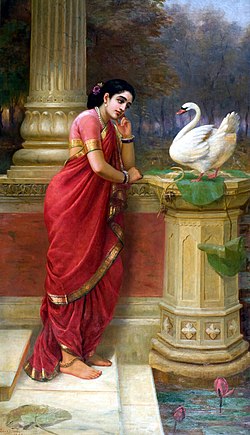Damayanti
| Damayanti | |
|---|---|
 Damayanti talking to the celestial swan about Nala, painting by Raja Ravi Varma | |
| Information | |
| Gender | Female |
| Family | Bhima of Vidarbha (father) |
| Spouse | Nala |
| Children | Indrasena (son) Indrasenā (daughter) |
| Home | Vidarbha Kingdom |
Damayanti (Sanskrit: दमयंती) is a character in a love story found in the Vana Parva book of the Mahabharata.[1] She was the daughter of Bhima (not the Pandava one) and a princess of the Vidarbha Kingdom, who married King Nala of the Nishadha Kingdom. The character is also found in other Hindu texts by many authors in numerous Indian languages.[2] She, along with Nala, are the central characters in the 12th century text Nishadha Charita, one of the five mahakavyas (great epic poems) in the canon of Sanskrit literature,[3][4]:136 written by Sriharsha.
Story[edit]
Damayanti was the Yadava princess of Vidarbha Kingdom. One day, a beautiful swan came to her and told her about Nala, king of Nishada. The swan was sent by Nala after hearing about her from it. After hearing about Nala, she was impressed with him and wanted to marry him.[5] A swayamvara was organized by Damayanti's father and Nala was also invited. Damayanti chose Nala out of the kings and princes and married. After a few years, they had two children.[6]
After many years of happiness, Pushkara, Nala's cousin, offered Nala to play a game. A rule was that the winner would get the loser's kingdom and the loser would go for an exile for three years. Nala lost the game and along with Damayanti went to the forest. Their children were given to Damayanti's father. Life was not easy for them and they struggled and wandered in the forest. One day when Damayanti was sleeping, Nala woke up and walked nearby.

He then suddenly saw a Naga god in fire and he saved him. The Naga god in return changed Nala's appearance and told him to learn the skill of the game from the king Rituparna of Ayodhya so that he could get back his kingdom. Nala went to Ayodhya without informing Damayanti, which left her searching for him. Damayanti was attacked by a python but it was killed by a hunter. Captivated by Damayanti's beauty, the hunter tried to force himself on her but she cursed him to be burnt into ashes.
After the hunter was burnt, Damayanti was rescued by a group of traders. However one night a herd of elephants destroyed the traders' belongings and the traders started to beat Damayanti as they thought she had brought them bad luck. Running for her life, Damayanti reached Viprapur. There she was chosen as the maid by the queen, Bhanumati. One day, a minister recognized who the maid was and brought her back to Vidarbha. Later she sent a question to all kingdoms to identify where Nala was. Nala answered the question and he was called to Vidarbha. There he reunited with Damayanti and they went to Nishada. Nala challenged Puskara but this time Pushkara lost. Nala got his kingdom back and he lived a happy life with Damayanti.[7]
Translations[edit]
Norman Mosley Penzer translated the tale of Nala and Damayanti in 1926 into English.[8]
See also[edit]
References[edit]
- ↑ J. A. B. van Buitenen (1981). The Mahabharata, Volume 2. University of Chicago Press. pp. 318–322. ISBN 978-0-226-84664-4.
- ↑ Roshen Dalal (2010). Hinduism: An Alphabetical Guide. Penguin Books. pp. 109, 191, 282, 316. ISBN 978-0-14-341421-6.
- ↑ The Indian Encyclopaedia. Genesis Publishing. p. 5079.
- ↑ C.Kunhan Raja. Survey of Sanskrit Literature. Bharatiya Vidya Bhavan. pp. 136, 146–148.
- ↑ Ritu (24 April 2014). "The love story of Nala and Damyanti". Indian Mythology. Retrieved 26 August 2020.
- ↑ Nala Damayanti. Amar Chitra Katha Private Limited. ISBN 81-89999-29-X.
- ↑ Nala Damayanti. Amar Chitra Katha Private Limited. ISBN 81-89999-29-X.
- ↑ S. M. E. (April 1927). "Nala and Damayanti by Norman M. Penzer". The Journal of the Royal Asiatic Society of Great Britain and Ireland (2): 363–364. JSTOR 25221149.
Further reading[edit]
- Goswami, B.N. (2015). Nala and Damayanti: A Great Series of Paintings of an Old Indian Romance. Niyogi Books. ISBN 9789383098897.
- Dallapiccola, Anna Libera (2002). Dictionary of Hindu Lore and Legend. Thames & Hudson. ISBN 978-0-500-51088-9.
- Doniger, Wendy (1999). "Chapter 3: Nala and Damayanti, Odysseus and Penelope". Splitting the Difference: Gender and Myth in Ancient Greece and India. University of Chicago Press. pp. 133–204. ISBN 978-0-226-15640-8.
External links[edit]
- The Naishadha-Charita (story of Nala and Damayanti) English translation by K. K. Handiqui [proofread] (includes glossary)
- Story of Nala and Damayanti English Translation
- Story of Nala and Damayanti from Mahabharata


